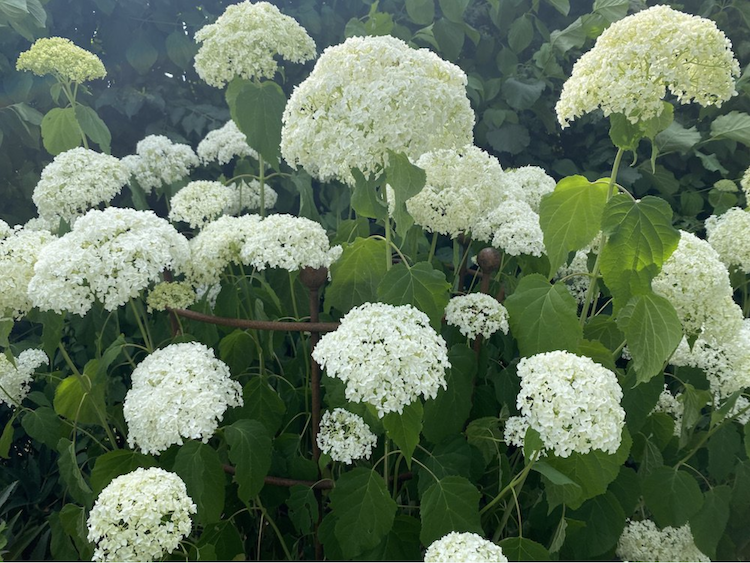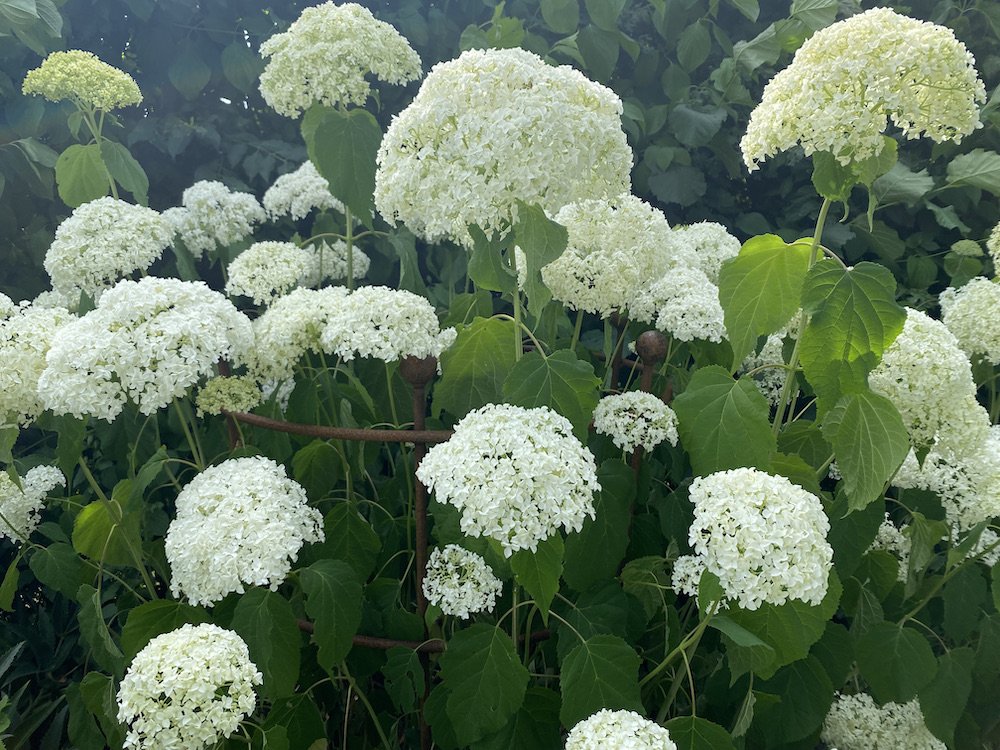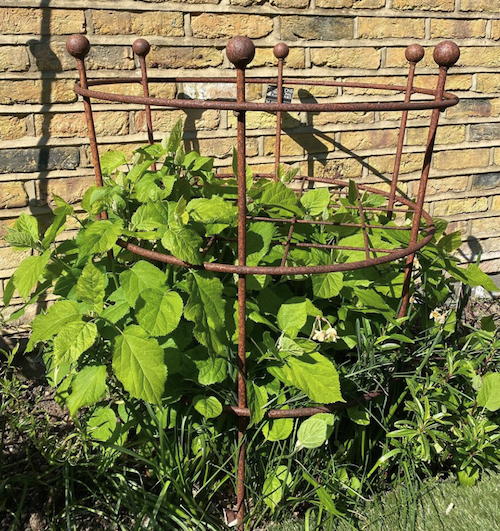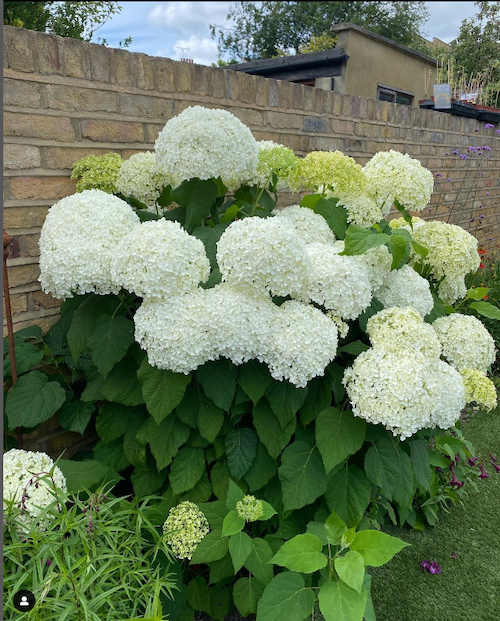
Planting Hydrangea Annabelle: Expert Tips for Success
Lesley Ann SandbachHydrangea 'Annabelle' is a true gem in any British garden, known for its stunning, voluminous white flower heads that can light up shady corners and add elegance to sunny borders. This beloved cultivar, a type of Hydrangea arborescens, is favoured by many gardeners for its hardiness and ease of care.
Whether you're a seasoned gardener or a newcomer to horticulture, 'Annabelle' offers a blend of beauty and simplicity, making it a must-have for anyone looking to enhance their outdoor space.

In this article, we’ll cover everything you need to know about growing and caring for 'Annabelle' in the UK and discover how some Muntons clients have used our plant supports to keep their hydrangeas looking their best.
Understanding ‘Annabelle’
Hydrangea 'Annabelle' is a large, bushy, North American shrub, celebrated for its large, spherical clusters of white flowers that can reach up to 25 cm in diameter. These blooms, which appear from late spring to early autumn, can transform any garden space with their lush, full appearance. 'Annabelle' is particularly valued for its ability to thrive in various light conditions, from full sun to partial shade, making it versatile for different garden settings. Its robust nature and adaptability to the UK climate make it a reliable choice for gardeners, and as such it has been given The Royal Horticultural Society’s Award of Garden Merit (AGM).
When and where to plant Hydrangea ‘Annabelle’
The ideal time to plant Hydrangea 'Annabelle' is in late spring or early autumn when the soil is warm but not too hot, giving the plant ample time to establish roots before the extremes of summer or winter.
While 'Annabelle' can tolerate full sun, it prefers partial shade, especially in hotter regions of the UK. Too much direct sunlight can cause the blooms to fade and the leaves to scorch. As for soil preferences, the plant thrives in moist but well-drained, fertile soil rich in organic matter. Slightly acidic to neutral pH levels are ideal.
How to plant
Prepare the Soil: Dig a hole twice the width of the root ball and just as deep. Adjust the soil with compost to improve fertility and drainage.
Planting: Place the plant in the hole, ensuring the top of the root ball is level with the surrounding soil. Fill in with soil, pressing down gently to eliminate air pockets.
Watering: Water thoroughly to settle the soil around the roots. Apply a layer of mulch to retain moisture and regulate soil temperature.
‘Annabelle’ looks great when planted as a focal point in mixed borders, or planted en masse along driveways, paths and property lines for a dramatic effect (scroll down to see how Denmans has achieved this look). Alternatively you might consider planting 'Annabelle' in large containers for your patio or courtyard garden. It also works well in woodland gardens and cottage-style landscapes, where you could plant it with shade-loving plants like hostas, ferns, and astilbes for a lush, layered look.
Pruning
Hydrangea ‘Annabelle’ flowers on new growth and so I trim the faded flower heads in the autumn but leave the old wood on to offer winter protection. In spring, when the new growth is beginning at the base of the plant, I prune back to a strong pair of buds 10-20cms above ground and give the plants a good mulch of compost.

For more tips on how to care for and get the best out of your hydrangea ‘Annabelle’, I went to one of our clients, Mark Hayhurst. Here is what he says:
“Stretch your budget as much as you can to get a mature as possible specimen, you will be instantly rewarded and it will prove a solid investment for years to come. I bought my first ‘Annabelle’ (of which I now have quite a few) over 10 years ago at the Hampton Court Flower show from a nursery stand and am getting flower heads over 15 inches in diameter! Garden shows are a great place to buy specimen plants, as nurseries bring their best to the show to show off their talent and typically sell them at the end. We also visit a show on the last day to benefit from the sales and plants available!
Feed, feed and feed, on a weekly basis during the early growing season with an ericaceous liquid feed. This will really set up your hydrangea for the flowering, giving it the energy it needs to put on a stunning show.
Water, water, water - as the name suggests hydrangea - it thrives on being well watered, so during periods of no rainfall, do ensure you water it well, giving it more than you think. I give mine each of mine a good soaking of at least a minute for each plant.
Staking - I am a self-confessed Muntons fan - their 3-Ring Herbaceous Supports with a grid fit the bill perfectly. It supports the growth wonderfully and most importantly helps to avoid the flower heads from snapping when they become top heavy after rainfall.”


Very good advice – well, I would say that, wouldn’t I, given Mark’s endorsement of our supports! Whilst Mark prefers the supports with a grid ; I always recommend our large 3-ring herbaceous supports – they don’t feature a grid, but the shape and height of the supports is the same.
These supports might seem very large for young plants but I promise you that after 3 or 4 years your hydrangea ‘Annabelle’ will completely fill its support, giving you the pleasure of its flowers rather than the unsightly sprawl of their unsupported branches.
More 'Annabelle' Inspiration
One garden that I always enjoy visiting is Denmans. Now curated and nurtured by Gwendolyn van Paasschen, Denmans promotes the design and legacy of John Brookes MBE. John was one of the nation’s foremost twentieth century landscape designers and his designs and gardening philosophy crystallised in the garden that he created for Mrs Joyce Robinson, a knowledgeable plantswoman, who designed a gravel garden as early as 1969. ‘Annabelles’ were John Brookes’ favourite hydrangeas and he used them all the time in his designs.
Gwendolyn continues to enhance and update Brooke’s concept (no plan was ever drawn for the garden which evolved over the years) and I was very struck by her stand of ‘Annabelles’ growing strongly through their 3-ring herbaceous supports – just the kind of massed planting that suits ‘Annabelle’.

I hope you’re feeling suitably informed and inspired. Hydrangea 'Annabelle' is a versatile and resilient addition to any UK garden, offering breathtaking blooms and minimal maintenance. By following the tips and techniques outlined in this guide, you can ensure your 'Annabelle' thrives and remains a focal point in your garden for years to come.
